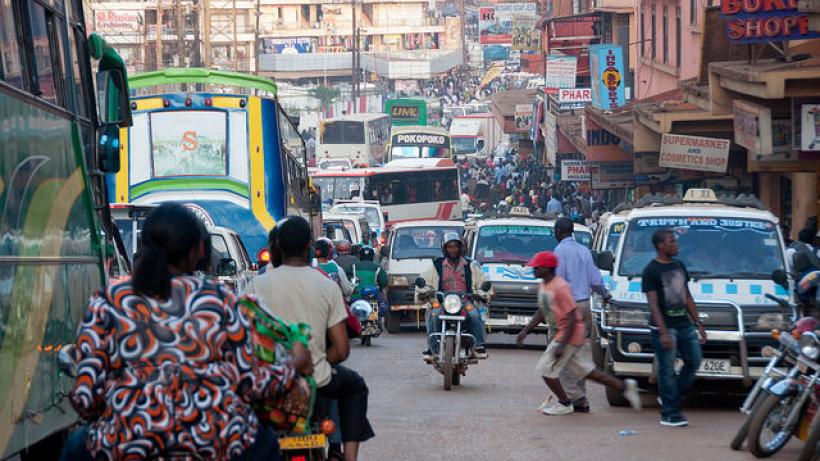
From roads to regulation: Realistic transport reform in Greater Kampala
Across developing cities, transportation is struggling to keep up with rapid population growth. Transport systems that are supposed to connect individuals to jobs, services, and markets have limited reach and low capacity. Land allocated to roads in sub-Saharan African cities, for example, is around a third of that in cities in other parts of the world (Collier and Venables 2016). The result is congested city centres and disconnected suburbs. Similar problems are being faced in the Greater Kampala Metropolitan Area (GKMA), but successful reforms in other cities offer key lessons for future policy.
At the recent Cities that Work workshop on urban mobility in the GKMA, key areas for transport reform were discussed. Policymakers and practitioners from Accra, Lagos, and Kampala came together to discuss experiences of reform and set a realistic agenda for transport policy.
Kampala in gridlock
As Kampala has grown, so has its traffic problem. Despite continued investments in roads in Kampala city, infrastructure for both public and private transport is limited in surrounding districts – a significant issue in a city where roughly half the daytime population commutes in from outside the city limits. At the same time, public transport services are dominated by informal minibus and motorbike operators that are low capacity and irregular in their routes, contributing significantly to gridlock in the city.
Getting the wheels turning: First steps for reform
In this context, the city is considering a variety of options for improving mobility – including the introduction of a bus rapid transit (BRT) system. If implemented, such a high capacity public transport system has the potential to significantly improve mobility in the city. The introduction of a BRT in Dar es Salaam, for example, has reportedly reduced travel times by up to 75% (Lombard 2017). But implementing these systems is financially and politically costly, and requires high levels of enforcement. Successful transport improvements from London to Lagos have crucially relied on incremental reforms that allow governments to build up public support for transport policy over time. These experiences suggest some potential first steps for Greater Kampala.
-
Smart infrastructure investments
Infrastructure investment in the GKMA has so far focused predominantly on the construction of new roads. Whilst the expansion of roads is a vital part of expanding access to different areas in the city, this is unlikely to be enough to address congestion in the city. Acquisition of land in Kampala comes at a high cost, whilst evidence from a number of cities suggests that building roads will only induce more people to drive on them (Duranton and Turner 2009).
Instead, investments to make the most of existing infrastructure can play a crucial role in improving mobility. In Lagos, for example, minor investments in traffic management solutions such as the conversion of roundabouts to signalised junctions has reduced travel times from two hours to 30 minutes in some parts of the city. At the same time, the city can work towards higher capacity transport by prioritising specific, highly congested routes for the introduction of a BRT ‘Lite’ system that can be upgraded over time. A similar process was seen in Lagos, where a 14km BRT Lite system was piloted along a highly congested route before investments were subsequently made in extending and upgrading the system.
-
Realistic regulation
Informal matatu minibuses and motorbikes form the backbone of public transport in the city – but contribute significantly to congestion. The city has attempted to regulate the quality and quantity of these services in the past, but with limited success, given strong resistance from transport unions. Successful regulation in Accra and Lagos highlight that combining regulations with financial support can be key to overcoming this resistance. In these cities, governments provided the finance, or financial guarantees, that allowed existing informal vehicle owners to form cooperatives and jointly invest in higher capacity buses. To ensure these high capacity buses were financially sustainable, financial support was combined with regulation to enforce exclusive use of particular routes. Public transport needs were met and congestion was reduced while maintaining crucial political support for the introduction of higher capacity buses. Government support for similar schemes in Kampala can be the first step in getting the vehicles – and the public support - for higher capacity systems.
Through cooperatives such as Awakule Ennume, taxi owners have begun to jointly invest in higher capacity buses in the city
Key considerations for future reform: Funding and coordination
Any transport investments in the city will require further consideration of two key factors: funding and coordination. While public-private partnerships are increasingly being considered to finance and provide transport services in developing cities, they are by no means a silver bullet; initial investments will need to be paid back over time – with interest. User fees offer one source of funding that can also help to manage demand for transport services, but cross-country evidence highlights that public transport systems are rarely able to recover costs through these fees alone. At the same time, lack of coordination between districts in the GKMA currently limits the potential gains from investments. Some clear method of coordination between districts will be crucial in lowering costs of investment and more equitably sharing the costs and benefits of investments in roads and public transport systems (Slack 2018).
Kampala faces a significant challenge in improving its transport systems, but successful reforms from other developing cities offer some realistic first steps for policy.


